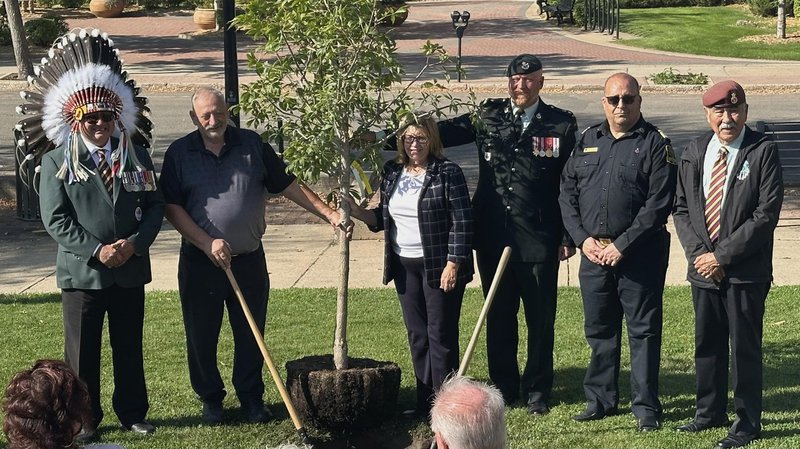Lifestyle
CAF Commemorates Wildfire Response with Tree Planting Ceremony

A ceremonial tree planting took place at Prince Albert City Hall on February 15, 2025, marking the tenth anniversary of the catastrophic wildfires that swept through Northern Saskatchewan. The event honored the efforts of the Canadian Armed Forces (CAF) during this emergency, with an Ohio Buckeye tree symbolizing gratitude and remembrance.
The ceremony commenced with a prayer and a traditional smudging ceremony for attendees and the newly planted tree. Local and provincial dignitaries, including Member of the Legislative Assembly (MLA) Alana Ross, participated in the event. Ross reflected on the 2015 wildfires, stating, “It was a time that tested our strength, our resilience, and our commitment to one another. The scale of the crisis was overwhelming, and yet communities, governments, and first responders from all levels became united for a powerful response. When our government asked for assistance, the Canadian Armed Forces stepped up.”
The wildfire season in 2015 remains one of the most severe on record in Saskatchewan. Over 700 fires ravaged nearly 1.8 million hectares of land, resulting in the evacuation of over 50 northern communities and approximately 13,000 people. This marked the largest evacuation in the province’s history and prompted the launch of Operation Lentus 15-02, which saw around 850 CAF members deployed to assist local firefighting teams.
The CAF played a crucial role in conducting fire line operations near towns and vital infrastructure, extinguishing hotspots in vulnerable communities, and providing logistical support. The operation was deemed a success, with no loss of life reported.
In attendance at the event was Lieutenant-Colonel Mike Graver, Commanding Officer of the North Saskatchewan Regiment, who was also part of the deployment in 2015. Graver shared his experiences, stating, “This operation is something that I’m very proud of. I remember rallying the troops to volunteer for this mission, emphasizing that it was a no-fail task on our home turf.” He led a domestic response company comprising soldiers from Ontario, Manitoba, and Saskatchewan, all part of the 38 Canadian Brigade Group.
Reflecting on their mission, Graver noted, “We had two weeks in and around La Ronge. We performed daily wildfire fighting, information gathering, and community support. To this day, I still run into people from that area, from La Ronge, and they’re still very thankful for the military assistance provided in that operation.”
Graver also highlighted the increasing frequency of military responses to wildfires across Canada, as summer fire outbreaks become more prevalent. In the summer of 2024, around 400 soldiers were again deployed to Northern Saskatchewan to combat over 480 wildfires. As of September 3, 2025, wildfires have scorched more than three million hectares of land.
“We, in the Canadian Armed Forces, train for these types of deployments, both foreign and domestic. It is our responsibility to protect our homeland, our borders, and our people above all else,” Graver emphasized. “This is why these deployments are so important to our soldiers and why I’m so proud of the support we provide to Northern Saskatchewan.”
The tree planting ceremony serves as a poignant reminder of the resilience of communities and the unwavering support of the Canadian Armed Forces during times of crisis.
-

 Education3 months ago
Education3 months agoBrandon University’s Failed $5 Million Project Sparks Oversight Review
-

 Science4 months ago
Science4 months agoMicrosoft Confirms U.S. Law Overrules Canadian Data Sovereignty
-

 Lifestyle3 months ago
Lifestyle3 months agoWinnipeg Celebrates Culinary Creativity During Le Burger Week 2025
-

 Health4 months ago
Health4 months agoMontreal’s Groupe Marcelle Leads Canadian Cosmetic Industry Growth
-

 Science4 months ago
Science4 months agoTech Innovator Amandipp Singh Transforms Hiring for Disabled
-

 Technology3 months ago
Technology3 months agoDragon Ball: Sparking! Zero Launching on Switch and Switch 2 This November
-

 Education3 months ago
Education3 months agoRed River College Launches New Programs to Address Industry Needs
-

 Technology4 months ago
Technology4 months agoGoogle Pixel 10 Pro Fold Specs Unveiled Ahead of Launch
-

 Business3 months ago
Business3 months agoRocket Lab Reports Strong Q2 2025 Revenue Growth and Future Plans
-

 Technology2 months ago
Technology2 months agoDiscord Faces Serious Security Breach Affecting Millions
-

 Education3 months ago
Education3 months agoAlberta Teachers’ Strike: Potential Impacts on Students and Families
-

 Science3 months ago
Science3 months agoChina’s Wukong Spacesuit Sets New Standard for AI in Space
-

 Education3 months ago
Education3 months agoNew SĆIȺNEW̱ SṮEȽIṮḴEȽ Elementary Opens in Langford for 2025/2026 Year
-

 Business4 months ago
Business4 months agoNew Estimates Reveal ChatGPT-5 Energy Use Could Soar
-

 Technology4 months ago
Technology4 months agoWorld of Warcraft Players Buzz Over 19-Quest Bee Challenge
-

 Business3 months ago
Business3 months agoDawson City Residents Rally Around Buy Canadian Movement
-

 Technology2 months ago
Technology2 months agoHuawei MatePad 12X Redefines Tablet Experience for Professionals
-

 Business3 months ago
Business3 months agoBNA Brewing to Open New Bowling Alley in Downtown Penticton
-

 Technology4 months ago
Technology4 months agoFuture Entertainment Launches DDoD with Gameplay Trailer Showcase
-

 Technology4 months ago
Technology4 months agoGlobal Launch of Ragnarok M: Classic Set for September 3, 2025
-

 Technology4 months ago
Technology4 months agoInnovative 140W GaN Travel Adapter Combines Power and Convenience
-

 Science4 months ago
Science4 months agoXi Labs Innovates with New AI Operating System Set for 2025 Launch
-

 Technology4 months ago
Technology4 months agoNew IDR01 Smart Ring Offers Advanced Sports Tracking for $169
-

 Top Stories2 months ago
Top Stories2 months agoBlue Jays Shift José Berríos to Bullpen Ahead of Playoffs










